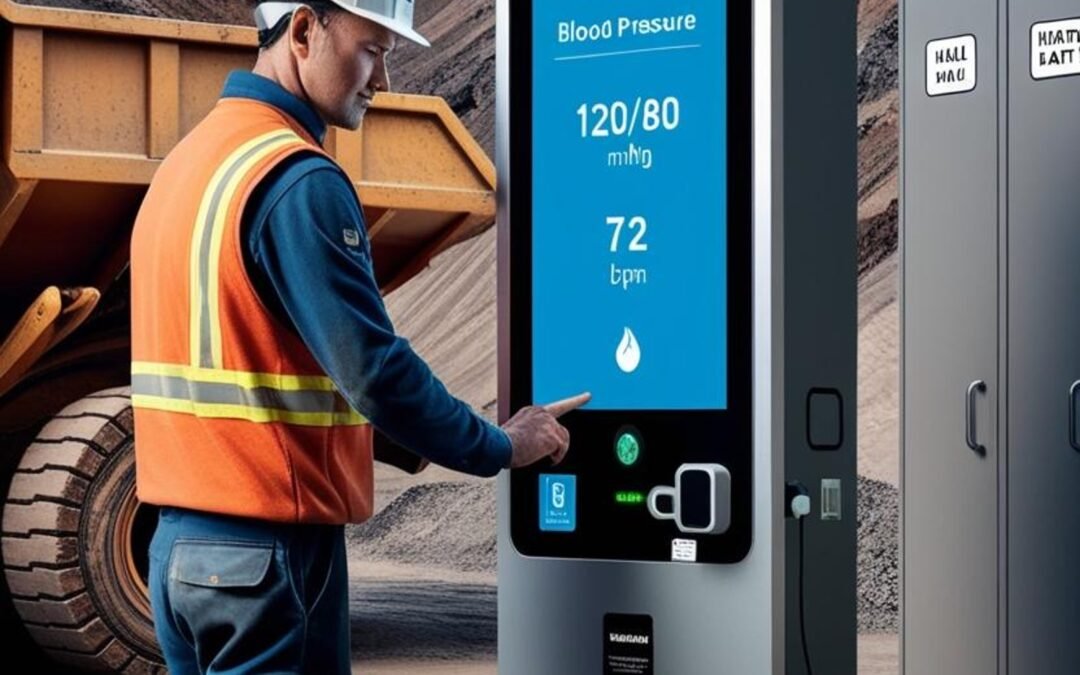Health Check Kiosks: Revolutionizing Mental health, Safety and Wellness in Mining
In the rugged, high-stakes world of mining, where workers endure extreme conditions and long shifts, health and safety are non-negotiable. A minor health issue—like fatigue or elevated blood pressure—can quickly escalate into a serious incident in this unforgiving environment. Enter health check kiosks: automated stations that allow miners to monitor vital signs such as blood pressure, heart rate, and oxygen levels in mere minutes. These innovative tools are emerging as a cost-effective solution for mining companies to enhance employee well-being, boost safety, and meet growing regulatory and sustainability demands. In this blog, we’ll dive into a detailed study on health kiosks in mining, exploring their benefits, challenges, real-world applications, and what the future holds.
What Are Health Kiosks and Why Mining Needs Them?
Health check kiosks are self-service stations equipped with sensors to measure key health metrics—think blood pressure, pulse, oxygen saturation, and even temperature. In mining, where workers face physical exhaustion, harsh climates, and remote locations, these kiosks offer a practical way to perform quick health screenings before or after shifts. Unlike traditional medical checkups, which require scheduling and travel, kiosks bring health monitoring directly to the worksite.
Mining is an industry where safety incidents can have devastating consequences. Fatigue, for instance, contributes to up to 65% of haul truck accidents, according to the U.S. Mine Safety and Health Administration (MSHA). By catching early warning signs—like irregular heart rates or dehydration—kiosks can prevent these incidents, making them a vital tool for an industry under pressure to improve worker welfare and comply with Environmental, Social, and Governance (ESG) goals.
The Benefits: Health, Safety, and Beyond
The advantages of health kiosks in mining are compelling, touching on health outcomes, operational efficiency, and corporate responsibility:
- Early Detection of Health Issues: Regular checks can spot problems like hypertension or low oxygen levels before they become emergencies. This is critical in remote mines where medical facilities are hours away.
- Enhanced Safety: By identifying fatigued or at-risk workers, kiosks reduce accident rates. Fewer incidents mean fewer injuries and less downtime—a win for both workers and companies.
- Mental Health Insights: Physical metrics often hint at psychological strain. Elevated blood pressure or heart rate can signal chronic stress or anxiety, opening the door to early mental health support—a growing priority in mining’s high-pressure environment.
- ESG and Compliance: Companies face increasing scrutiny to prioritize worker well-being. Kiosks provide concrete data to showcase health initiatives, aligning with regulations like South Africa’s Mine Health and Safety Act or Australia’s Work Health and Safety Act.
- Financial Returns: Studies suggest workplace wellness programs, including health screenings, yield $3.27 in medical cost savings for every dollar spent. For mining firms, this translates to reduced absenteeism and lower healthcare expenses.
The Challenges: Privacy, Trust, and Maintenance
No innovation is without hurdles, and health kiosks face a few key challenges:
- Privacy Concerns: Collecting health data triggers strict regulations like GDPR, HIPAA, or South Africa’s POPIA. Companies must ensure data is encrypted, access is restricted to medical professionals, and workers give informed consent.
- Employee Buy-In: Miners might hesitate if they fear health data could impact their jobs. Transparency—explaining that participation is voluntary and data isn’t used punitively—is essential to build trust.
- Maintenance Needs: Kiosks require regular calibration to maintain accuracy, especially in dusty, humid mine conditions. A faulty reading could erode confidence or miss a real issue, so ongoing upkeep is non-negotiable.
These challenges are manageable with careful planning—think discreet kiosk placement, clear communication, and robust maintenance schedules—but they underscore the need for a thoughtful rollout.
Kiosks vs. Wearables: Which Wins in Mining?
Wearables—smart helmets or fitness trackers—are another health monitoring option gaining traction in mining. They offer continuous tracking of metrics like heart rate or fatigue, but how do they stack up against kiosks?
- Psychological Impact: Wearables’ constant monitoring can spark anxiety, with workers fixated on every alert. Kiosks, used periodically, feel less invasive and stressful.
- Legal Risks: Wearables generate more data, amplifying privacy and consent issues under laws like GDPR. Kiosks, with their controlled, opt-in approach, pose fewer legal headaches.
- Practicality: Harsh mine conditions—dust, moisture, physical knocks—can compromise wearable durability and accuracy. Stationary kiosks, sheltered from these elements, are more reliable for now.
- Cost: A kiosk costing $8,000–$15,000 serves hundreds of workers, while equipping each miner with a $200–$500 wearable adds up fast.
For the short to medium term (3–5 years), kiosks edge out wearables as the practical choice. Wearables hold long-term promise, but their adoption hinges on overcoming durability, privacy, and acceptance barriers.
Case Study: Big Sky Minerals Puts Kiosks to the Test
Let’s bring this to life with a simulated case study from the study: Big Sky Minerals (BSM), a fictional open-pit mine with 1,000 workers. Facing rising fatigue-related incidents (25% of injuries), BSM piloted three kiosks in 2023 at high-traffic spots like the canteen and locker rooms. The 3-month trial was voluntary, with an occupational health nurse reviewing alerts for extreme readings.
Pilot Results:
- Adoption: 60–70 workers used the kiosks daily, with 18% flagging abnormal vitals—mostly mild hypertension. Two severe cases prompted emergency referrals.
- User Feedback: 88% found them easy to use; 72% felt more health-aware.
Encouraged, BSM scaled to 10 kiosks, integrating checks into shift routines (still optional) and launching a “Know Your Numbers” campaign.
Full Rollout Outcomes (12 Months):
- Incident Drop: Health-related incidents fell 25%.
- Absenteeism Reduction: Sick days dropped from 4.8 to 4.2 per worker annually (12% decrease).
- Cost Savings: $150,000 saved yearly, offsetting the $120,000 kiosk investment.
- Employee Sentiment: 75% rated BSM’s health commitment as excellent, up from 55%.
Real-world parallels—like Anglo American’s WeCare program or BHP’s Wellness Pods—echo these gains, showing kiosks catch issues early and boost morale when trust is prioritized.
The Future: Where Are Kiosks Headed?
Health kiosks aren’t yet standard in mining, where traditional exams and hazard-specific devices dominate. But the study predicts growth over the next five years, fuelled by:
- Tech Advances: More durable, AI-enhanced kiosks could offer personalized insights or touchless operation.
- Mental Health Focus: Adding stress surveys or biometric stress indicators could expand their role.
However, kiosks won’t reign alone. Wearables, mobile apps, and telemedicine will complement them, especially for continuous mental health support—a pressing need given mining’s isolation and shift demands. The NIOSH Miner Health Program envisions an integrated future, blending kiosks with IoT and analytics for a holistic approach.
Conclusion: A Smart Step Forward
Health check kiosks are poised to transform mining by putting worker health front and center. They deliver immediate benefits—fewer incidents, healthier teams, cost savings—while aligning with ESG and safety mandates. Challenges like privacy and upkeep are real but surmountable with the right strategy: voluntary use, secure data, and regular maintenance.
For now, kiosks outshine wearables as a practical, low-risk solution. As technology evolves, they’ll likely pave the way for broader health monitoring innovations. Mining companies ready to invest in this tech aren’t just enhancing safety—they’re building a more resilient, sustainable future for their workforce. Isn’t it time your operation took a closer look?

